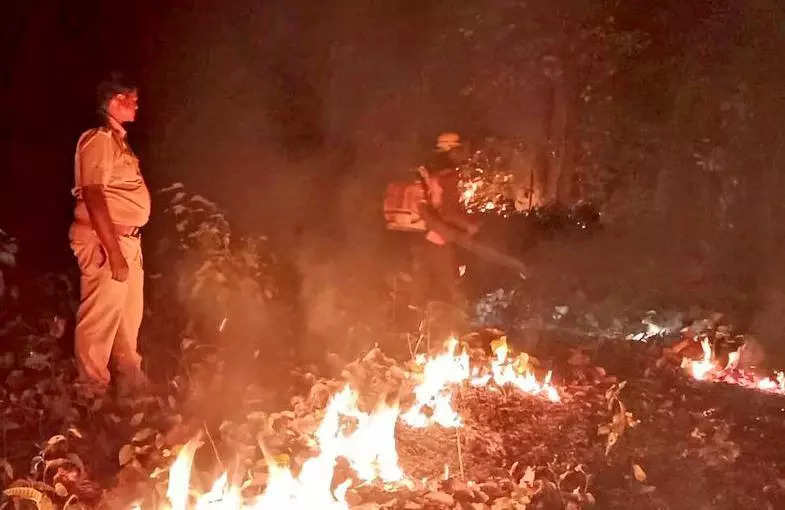Buffer zone of Similipal biosphere most affected by forest fires: Study | Bhubaneswar News

Bhubaneswar: The buffer zone of Similipal Biosphere Reserve is most affected in forest fires with most incidents linked to human activities such as agricultural expansion, illegal felling and forest resource extraction, a study by four researchers from Fakir Mohan University, Balasore, has found.
The paper, published in the journal, Environmental Science and Pollution Research, on Jan 30, analysed forest fire trends and susceptibility in Similipal Biosphere Reserve from 2012 to 2023 using four machine learning models — Extreme Gradient Boosting Tree (XGBTree), AdaBag, Random Forest (RF), and Gradient Boosting Machine (GBM).
Temporal analysis by researchers Manoranjan Mishra, Rajkumar Guria, Samiksha Mohanta and Suman Paul revealed that 2021 was the peak year for forest fire incidents, with 94.72% occurring between March and April. The study also found that high and very high fire susceptibility zones covered 40.8% of the total area, emphasising the urgent need for targeted mitigation strategies. “April is the worst month for forest fires in the biosphere reserve,” said Mishra, a professor of geography department of FMU. “The RF model outperformed other ML models in predicting fire-prone areas, achieving the highest accuracy,” he added.
“Forest fires pose a significant threat to biodiversity, ecosystem stability, and climate regulation. Similipal Biosphere Reserve has experienced a notable increase in forest fires, making fire risk assessment and management a priority. The study employs machine learning models and geospatial analysis to identify forest fire-prone areas and develop predictive zonation maps,” said Mishra.
He said the generated fire probability maps can guide policymakers, forest managers and disaster response teams in prioritising fire prevention measures. “Targeted interventions, such as controlled burning, firebreaks and early warning systems, can be implemented in high-risk areas to reduce spread of fire and minimise ecological damage. Additionally, integrating fire susceptibility models with real-time satellite data could enhance monitoring and response strategies,” he added.
The researchers also recommended community engagement as another crucial aspect of fire management. Raising awareness among local populations about fire risks and promoting sustainable land use practices can help mitigate anthropogenic fire triggers. The methodology can also be extended to other biodiversity hotspots, improving fire prediction and management on a broader scale, the researchers said.
The paper, published in the journal, Environmental Science and Pollution Research, on Jan 30, analysed forest fire trends and susceptibility in Similipal Biosphere Reserve from 2012 to 2023 using four machine learning models — Extreme Gradient Boosting Tree (XGBTree), AdaBag, Random Forest (RF), and Gradient Boosting Machine (GBM).
Temporal analysis by researchers Manoranjan Mishra, Rajkumar Guria, Samiksha Mohanta and Suman Paul revealed that 2021 was the peak year for forest fire incidents, with 94.72% occurring between March and April. The study also found that high and very high fire susceptibility zones covered 40.8% of the total area, emphasising the urgent need for targeted mitigation strategies. “April is the worst month for forest fires in the biosphere reserve,” said Mishra, a professor of geography department of FMU. “The RF model outperformed other ML models in predicting fire-prone areas, achieving the highest accuracy,” he added.
“Forest fires pose a significant threat to biodiversity, ecosystem stability, and climate regulation. Similipal Biosphere Reserve has experienced a notable increase in forest fires, making fire risk assessment and management a priority. The study employs machine learning models and geospatial analysis to identify forest fire-prone areas and develop predictive zonation maps,” said Mishra.
He said the generated fire probability maps can guide policymakers, forest managers and disaster response teams in prioritising fire prevention measures. “Targeted interventions, such as controlled burning, firebreaks and early warning systems, can be implemented in high-risk areas to reduce spread of fire and minimise ecological damage. Additionally, integrating fire susceptibility models with real-time satellite data could enhance monitoring and response strategies,” he added.
The researchers also recommended community engagement as another crucial aspect of fire management. Raising awareness among local populations about fire risks and promoting sustainable land use practices can help mitigate anthropogenic fire triggers. The methodology can also be extended to other biodiversity hotspots, improving fire prediction and management on a broader scale, the researchers said.
















